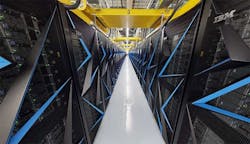Looking Ahead: Data Center Trends That May Surprise Us in 2021
Today we conclude our Data Center Executive Roundtable, a quarterly feature showcasing the insights of thought leaders on the state of the data center industry, and where it is headed. In today’s discussion, our panel of data center experts share their thoughts on trends that may surprise us in 2021. Our panelists include John Sabey of Sabey Data Centers. Intel’s Jeff Klaus, Maricel Cerruti from Infrastructure Masons, Chatsworth’s Todd Schneider, Ben Stewart of NTT Global Data Centers, Nortek’s Kris Holla, and Michael DeVito of Iron Mountain.
The conversation is moderated by Rich Miller, the founder and editor of Data Center Frontier.
Data Center Frontier: What will be surprised by in 2021? What are the trends you’re following that will make an outsized impact?
JOHN SABEY, Sabey Corporation
John Sabey (Sabey Corporation): I think we’ve all had enough negative surprises in 2020, so I’m looking to 2021 with great optimism!
One trend that I am watching closely, from a data center perspective, is interest rates. Financial decisions made in the US and globally in 2020 to mitigate the effects of the pandemic will eventually be reflected in the market, and likely in the form of an interest rate increase. Already on the rise, surging interest rates in 2021 would have a significant impact on data center pricing, both for end users and developers. I’m hoping that this doesn’t come to pass, but it’s only prudent to keep it in mind while making plans for the new year.
BEN STEWART, NTT Global Data Centers, Americas
Ben Stewart (NTT Global Data Centers Americas): Every year holds surprises, and I’m sure 2021 will be no different. Looking back at 2020, who saw COVID coming? And when it came, who forecasted the profound and dramatic changes COVID generated as a forcing-function? The pandemic completely surprised us in ways we’re still coming to understand. As a positive example, look at how the pandemic forced a change in our energy use impacting changes in our environment? And how lasting might those changes be?
The surprise in 2021 will likely be discovering all the still unknown ways this pandemic has and will impact our industry. The pandemic is far from over, and its impacts will indeed persist long after the contagion calms.
MARICEL CERRUTI, Teladata and Infrastructure Masons.
Maricel Cerruti (Infrastructure Masons): The journey in 2021 will continue to be a recovery but also a transformation phase for many businesses. I think we will continue to see an acceleration in digital adoption and growth trend in response to changes in customer behavior, communication, and experiences. Businesses will continue to invest in digital solutions such as cloud, automation, IoT, big data, and AI to improve operations and increase resiliency.
Many organizations were forced into remote work this year and there are questions about whether remote work will last. Although I think organizations will incorporate a hybrid model, I also think remote work will be a much bigger piece of business strategy for many firms. Companies are seeing the benefits of operating in a virtual world and are providing more opportunities to marginalized number of groups.
Remote work allows for more access to wider pool of talent that offers diverse skillsets, backgrounds, cultures, and experiences. It also eliminates workplace accessibility challenges for people with disabilities. Working remotely, combined with a more flexible work schedule, is also attractive to many new parents or women who may be struggling with child or family care responsibilities. Additionally, it highlights productivity and effectiveness and moves away from biases that sometimes cloud the judgement of individuals in an organization, leveling the playing field for all employees.
TODD SCHNEIDER, Chatsworth Products
Todd Schneider (Chatsworth Products): After 2020, it would be difficult to be surprised by anything. However, we are at an exciting time in terms of what emerging technologies to keep our eyes on. The roll-out of 5G wireless, the need to support edge computing and low-latency applications, the growing popularity of electric and autonomous vehicles, and the promise of blockchain gaining traction within large fintech companies like PayPal and others are all trends that can have major impact in 2021.
Infrastructure buildouts for many will continue to evolve and with the realization of new use cases for data and low-latency applications, digital transformation will move into the next phase, where infrastructure and connection will be truly ubiquitous.
MICHAEL DeVITO, Iron Mountain
Michael DeVito (Iron Mountain): Data center sustainability will be a major initiative for the industry and ourselves for 2021. Next to that, the hyperscale uptake will also keep driving business forward as they can invest and plan their business over the COVID-19 pandemic which is essential for continued growth in our industry.
There are also several industry drivers such as 5G, gaming, IoT and AI that will find their way to more and more end users which will drive and create new capacity needs, specifically around edge locations that sit as close as possible to the end user. But as 5G, gaming, IoT and AI will become more and more industry drivers we also feel that connectivity-driven ecosystems will be extremely important to accelerate these trends.
Connectivity-rich ecosystems enable colocation partners to provide significant value add through supplier diversification, accelerated deployments and extended reach across global markets. These ecosystems have evolved rapidly from specific markets such as financial services into connected communities, enabled by API-driven value chains, into covering the full range of Enterprise transformation needs. The ability of a data center ecosystem to facilitate global transactions is likely to be the defining value that differentiates colocation platforms in 2021 and beyond.
KRIS HOLLA, Nortek Air Solutions
Kris Holla (Nortek Air Solutions): Corporations will continue to be surprised at how much and how well their businesses can run in a virtual environment. COVID-19 has accelerated this process, but we’ve only scratched the surface in 2020. Face-to-face meetings will always be important for sales, but until business people start traveling regularly again, corporations are taking travel budgets and investing in virtual environment tools.
I think there will be more surprises with new companies that develop platforms, but have few physical assets. Uber, for example, is very profitable due to the platform it developed, but has no physical transportation assets. I think it will be surprising to see how many industries adapt similar virtual platforms. They will need to depend on the data center industry for their commerce. These platform companies will also depend on employees to work remotely and be provided work space tools in their home offices in 2021.
Digital companies will continue to disrupt traditional business models throughout 2021. An example is Amazon’s recent entry into medical drug distribution, which will take a toll on traditional wholesale and retail pharmaceutical channels. Another surprise coming in 2021 is data center operators taking the lead of the hyperscale companies on sustainability and the industry trend of transitioning to liquid cooling, which enables unprecedented water and power conservation, energy recovery, recycled water, solar, wind and other sustainable trends.
JEFF KLAUS, Intel
Jeff Klaus (Intel): I think we’ll see even more growth from 5G as we start to really see innovations in transportation and healthcare take off. As people recognize that we can innovate faster in these areas when we have better connections and data, we’ll see a lot more consumer products that have some smart services (with an AI component) connected to it.
RECAP: Links to all the Roundtable articles and Executive Insights transcripts for all our participants.
Keep pace with the fact-moving world of data centers and cloud computing by following us on Twitter and Facebook, connecting with me on LinkedIn, and signing up for our weekly newspaper using the form below:
About the Author




